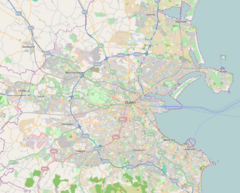Lucan Manor
| Lucan House | |
|---|---|
 Lucan House (1775), now the residence of the Italian ambassador in Ireland | |
| Former names | Lucan Manor |
| General information | |
| Type | House |
| Architectural style | Palladian |
| Town or city | Lucan, Dublin |
| Country | Ireland |
| Coordinates | 53°21′25.92″N 6°27′10.99″W / 53.3572000°N 6.4530528°W |
| Current tenants | Vacant |
| Construction started | 1772 |
| Estimated completion | 1775 |
| Owner | South Dublin County Council |
| Technical details | |
| Material | granite and pebble dash |
| Floor count | 3 |
| Design and construction | |
| Architect(s) | William Chambers Agmondisham Vesey James Wyatt (interior, oval office and sarsfield monument) |
| Developer | Agmondisham Vesey |
| Other designers | Michael Stapleton (stucco work) |
| Designations | Protected Structure[1] |
| References | |
| [2] | |
Lucan Manor is a Georgian-Palladian house and estate in Lucan, County Dublin. A manor house, it is remembered particularly for its association with the Sarsfield family. A castle or house has been recorded on the site since at least the 12th century.
History[edit]
Lucan manor is mentioned on the pipe roll as far back as 1272 when it was granted to Norman lords on the conquest of Ireland.[3][4]
The Sarsfield family first acquired Lucan when it was bought in 1566 by the Tudor era figure Sir William Sarsfield who passed it on to his younger son. The Manor remained in the hands of the Sarsfields until the Cromwellian conquest of Ireland when they were dispossessed of it due to Patrick Sarsfield's role in the Irish Rebellion of 1641.
It was then awarded to the Irish soldier Sir Theophilus Jones. After the Irish Restoration in 1660, the Sarsfields attempted to recover the estate. Despite their appeals being rejected in court, they were eventually able to secure its return following the intervention of Charles II.[5] There were further disputes following the death of William Sarsfield in 1675, with the manor eventually passing to his daughter, Charlotte Sarsfield, who married Agmondisham Vesey.[6][7]
Lucan Manor was demolished in the 1770s. Its Georgian era Palladian villa replacement, Lucan House, was constructed around 1775 by Agmondisham Vesey and today still stands on the site.[8] Upon the death of Vesey in 1785, the house and estate passed to his son George Vesey.[9] On his death the house passed to his daughter Elizabeth Vesey and her husband Sir Nicholas Colthurst, 4th Baronet. They and their descendants then had the house from 1836 to 1921.[10]
The contents of the house were sold in their entirety in September 1925 by Sir Richard St John Jefferyes Colthurst, 8th Baronet.[11]
Later, the house was acquired by Charles Hugh O'Conor, the son of Charles Owen O'Conor in the 1930s.[12]
The house was owned by William Teeling for a period in the 1940s when it featured in Country Life magazine.[13]
As of 2022, the house is the residence of the Italian ambassador to Ireland. The Italian government had been renting the property since 1942 and acquired the property in 1954.[14][15][16]
In 2023, the house was acquired by South Dublin County Council for around €15m with the Italian ambassador moving to a large house in Dartry.[17][18]

References[edit]
- ^ "Record of Protected Structures - SDCC" (PDF). Retrieved 21 September 2022.
- ^ "Dictionary of Irish Architects". www.dia.ie. Retrieved 17 April 2024.
- ^ "Royal Society of Antiquaries of Ireland". 1894. Retrieved 21 September 2022.
- ^ "Leamhcán/Lucan". logainm.ie. Retrieved 21 September 2022.
- ^ Wauchope p.2-10
- ^ "Palladio preserved in Lucan House and demesne". The Irish Times. Retrieved 20 September 2022.
- ^ "The River Liffey in Lucan House Demesne". onlinecollection.nationalgallery.ie. Retrieved 21 September 2022.
- ^ "Lucan House, Lucan House Demesne, LUCAN DEMESNE, Lucan, DUBLIN". Buildings of Ireland. Retrieved 19 September 2022.
- ^ "Lot 130 - ENGLISH SCHOOL (LATE 18TH CENTURY)". www.lyonandturnbull.com. Retrieved 21 September 2022.
- ^ "Lucan House & Spa". www.askaboutireland.ie. Retrieved 22 September 2022.
- ^ "Palladio preserved in Lucan House and demesne". The Irish Times. Retrieved 24 April 2024.
- ^ "Lucan Newsletter". www.lucannewsletter.ie. Retrieved 21 September 2022.
- ^ "Country Life magazine on Lucan House Co. Dublin January 31st 1947". Rostron & Edwards. Retrieved 4 April 2024.
- ^ "Lucan-House - YCBA Collections Search". collections.britishart.yale.edu. Retrieved 20 September 2022.
- ^ "View of Lucan House - YCBA Collections Search". collections.britishart.yale.edu. Retrieved 20 September 2022.
- ^ "A collection of select views from the different seats of the nobility and gentry in the Kingdom of Ireland / engraved by Thomas Milton. From original drawings, by the best masters. - YCBA Collections Search". collections.britishart.yale.edu. Retrieved 20 September 2022.
- ^ O'Leary, Kim (4 September 2023). "Lucan House bought for whopping €15m by local authority". DublinLive. Retrieved 5 September 2023.
- ^ "Italian embassy to pay €7.5m for six-bedroom Dartry residence". The Irish Times. Retrieved 15 March 2024.
Bibliography[edit]
- Wauchope, Piers. Patrick Sarsfield and the Williamite War. Irish Academic Press, 1992.


